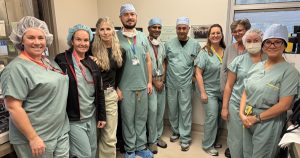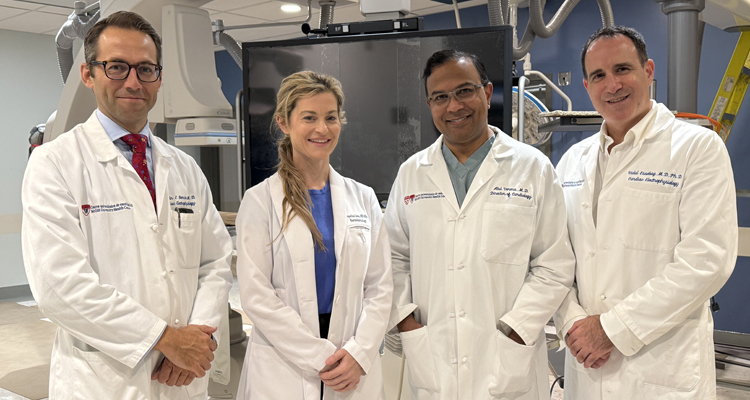Every day, over 200 Canadians lose their lives to heart disease or stroke. That’s more than 90,000 individuals every year – mothers, fathers, children – with each loss devastating entire families and communities. Heart disease, the leading cause of death in Canada, is a growing crisis. With an aging population and increasingly sedentary lifestyles, hospitals are facing overwhelming pressure, struggling to provide timely and comprehensive care to those who need it most.
At the McGill University Health Centre (MUHC)’s Glen site, an exciting new space has been opened—an electrophysiology (EP) laboratory equipped with the latest technology to treat and diagnose all complex arrhythmias, or irregular heartbeats. Thanks to the generosity of hundreds of donors to the MUHC Foundation, who collectively raised a transformative $6 million to equip the Glen site with a state-of-the-art EP laboratory.
What is electrophysiology?
At its core, the heart is an electrical organ. Every beat you feel is powered by tiny electrical impulses that ensure the heart contracts in a steady, rhythmic pattern. But sometimes, this rhythm goes awry. This is known as arrhythmia, and if left untreated, it can lead to serious complications like stroke, heart failure, or sudden cardiac arrest.

Members of the MUHC’s Cardiac Electrophysiology Team, including the nurse manager, research manager, nurses, technician, patient attendant, administrative support, and fellows.
Electrophysiology is the branch of cardiology that studies the electrical activities of the heart. Using advanced technology, electrophysiologists map the heart’s electrical pathways to pinpoint problem areas and offer treatments such as ablation, pacemakers, or defibrillators.
The newly opened EP laboratory at the Glen will enable the MUHC’s doctors to efficiently treat more patients requiring complex heart rhythm procedures. This will reduce critical delays, which can often mean the difference between life and death.
“Every second counts – the new EP lab at the Glen means that we now have increased capacity to treat patients sooner, before their conditions deteriorate,” explains Dr. Vidal Essebag, Clinician Scientist and Director of Cardiac Electrophysiology at the MUHC.
Cardiovascular disease accounts for more hospitalizations than any other illness in Canada. In fact, 40% of patients treated for heart disease require readmission due to more complex care needs. Many of these cases involve arrhythmias that could be treated or managed in an electrophysiology lab, reducing the risk of complications and death.
Catheter ablation is one of the most effective treatments for certain arrhythmias. It involves threading thin wires through a blood vessel in the groin and up to the heart. Once inside, electrophysiologists use real-time imaging to map the heart’s electrical signals and locate the problem areas. They then apply energy to destroy these malfunctioning cells, restoring the heart’s normal rhythm.
“This procedure not only improves the quality of life of our patients but has been shown to lower mortality and prevent heart failure and strokes,” shares Dr. Jacqueline Joza, a Clinician Scientist, Cardiac Electrophysiologist and Director of the Inherited Arrhythmia Service at the MUHC.
Another exciting undertaking at the MUHC’s electrophysiology laboratory is pulse field ablation (PFA), a non-thermal energy technique that offers a safer, less invasive way to treat arrhythmias.
“Unlike traditional methods using heat or freezing, which can damage surrounding tissues, PFA is minimally invasive—it more specifically targets abnormal heart cells with electrical pulses,” explains Dr. Essebag. The MUHC is the only centre in the Americas partnering with six companies to develop and research this promising technology, marking its position as a leader in understanding newer forms of pacing and resynchronization therapy.
Integrated care for complex cases
Heart disease rarely exists in isolation. Many patients suffering from arrhythmias also have other serious health conditions. The Glen’s new EP laboratory offers a strategic advantage—it is housed within a comprehensive care facility that includes world-class oncology, transplant, prevention, women’s health and cardiac surgery units.
“For the sickest patients, this integrated approach is crucial,” notes Dr. Atul Verma, Director of Cardiology and Cardiac Electrophysiologist at the MUHC, and an internationally renowned researcher. “In case of complications, we have the expertise and resources right here at the Glen. This lab will not only treat arrhythmias but will also provide the multidisciplinary care our most fragile patients need.”
The MUHC’s international reputation as a leader in electrophysiology has already attracted top talent from around the world. With this new facility, the hospital will continue to draw the best and brightest minds to Montreal, reinforcing Quebec as a global leader in heart health.
“We are fortunate to have some of the world’s leading experts in electrophysiology at the Glen,” says Dr. Martin Bernier, Director of the MUHC’s Cardiac Electrophysiology Training Program. “This lab will give us the platform we need to grow and secure the future of heart health in Quebec and globally.”
While the focus is on patient care, the Glen’s integration of research and patient care means that patients will always be among the first to benefit from the incredible innovation takes place on-site. Dr. Fiorella Rafti, Research Manager for cardiac electrophysiology, believes that the potential for discovery is limitless.
“Electrophysiology is a rapidly evolving field, and this lab gives us a serious advantage,” she says. “We have one of the highest patient recruitment rates for clinical trials in the world, which means we can continue to make significant contributions to the future of cardiac care.”
At its core, the MUHC’s new EP lab reflects these two things: the generosity of the MUHC Foundation’s donors and the unwavering commitment of the staff—from dedicated nurses and passionate researchers to world-renowned cardiologists—who have brought this transformative project to life.
“It is a pleasure to collaborate closely with the EP medical director to lead our wonderful team of professionals in providing excellence in clinical care, education and research,” shares Rosalynn Bautista, EP nurse manager at the MUHC.
“The Glen site EP lab has been a big dream since 2015, and we’re thrilled to finally see it come to life. As a Foundation, our mission is to fund the highest standard of care for Quebecers, and this new centre of excellence embodies everything we strive for. It’s a testament to the incredible impact we can achieve when we come together as a community,” says Marie-Hélène Laramée, President and CEO of the MUHC Foundation.
We hope you’ll consider supporting the experts working at the MUHC’s new electrophysiology laboratory by donating to the MUHC’s Dream Big: Fix Broken Hearts campaign: www.muhcfoundation.com/works/fix-broken-hearts
The MUHC Foundation is accredited by Imagine Canada for excellence in non-profit accountability, transparency and governance. www.muhcfoundation.com


